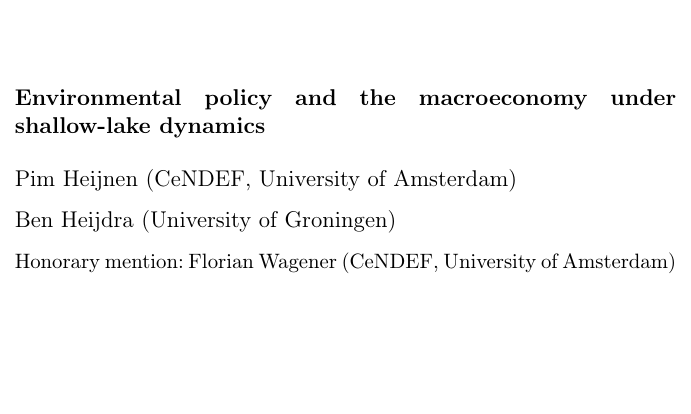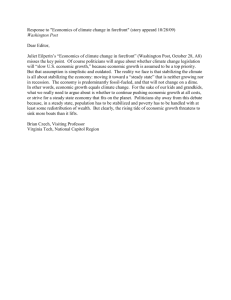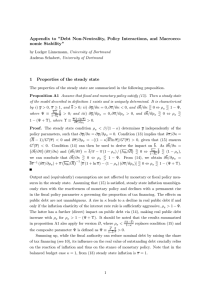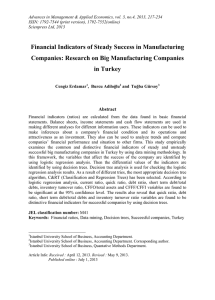Environmental policy and the

Environmental policy and the macroeconomy under shallow-lake dynamics
Pim Heijnen (CeNDEF, University of Amsterdam)
Ben Heijdra (University of Groningen)
Honorary mention: Florian Wagener (CeNDEF, University of Amsterdam)
Standard approach in environmental economics
Tradeoff between economic prosperity and a clean environment
Unique steady state for both the economy and the environment
Local analysis
Examples in:
→ nonrenewable resource extraction (Dasgupta & Heal, 1974)
→ renewable resource extraction (Munro, 1979)
→ environmental macro (Bovenberg & Heijdra, 1998)
Recent research in ecology (Scheffer et al., 2001)
Most ecological systems have multiple steady states
Examples:
→ Shallow lakes can be turbid or clear
→ Sahara dessert/savannah
Environmental dynamics are nonlinear
→ multiple steady states and catastrophic shifts
Our approach
Our approach (2)
The environment is in the bad steady state
The government is ‘inactive’
Temporary policy to move the environment to the good steady state
Simple (and standard) model of the economy to give an idea of:
→ the effects of the policy on the economy
→ cost-benefit analysis
The environment
P is pollution
D is inflow of pollution:
D = κK
|{z}
Capital stock
− γG
|{z}
Govt. measures
Evolution of pollution:
P
2
P
˙
= D − πP +
P 2 + 1
The economy (base model)
Representative agent with a fixed labor supply (of one unit)
Utility (and welfare measure):
Z
∞
[log C ( τ ) +
E log( ¯ − P ( τ ))] e
− ρτ
0 d τ
Agent chooses consumption to maximize utility
Competitive industry using capital and labor as inputs
The economy (base model, 2)
Using production function Y = Ω
0
K
1 −
δ :
L L L and depreciation rate
˙
= [(1 −
L
)Ω
0
K
−
L − δ − ρ ] C,
˙
= Ω
0
K
1 −
L − C − G − δK, where K (0) is given and C (0) such that budget constraint holds.
Policy experiment
K (0) and P (0) such that:
→ Region of multiple steady states
→ Currently in the bad steady state
Government temporarily increases spending by g for t ∈ [0 , t
E
] g = 0 .
1 and t
E
= 41 (minimal length to force environment to clean state)
Effect of policy on capital
2.75
2.7
2.65
2.6
2.55
2.5
2.45
2.4
0 10 20 30 post ï
40 shock time (t)
50 60 70 80
Effect of policy on consumption
0.81
0.8
0.79
0.78
0.77
0.76
0.75
0.74
0.73
0.72
0.71
0 10 20 30 post ï
40 shock time (t)
50 60 70 80
Effect of policy on pollution
0.8
0.6
0.4
1.2
1
0.2
0
0 10 20 30 post ï
40 shock time (t)
50 60 70 80
Base model: conclusions
Huge welfare effect: comparable to 26.3% extra consumption in the bad steady state
Cold turkey is slightly better: g = 0 .
1166 and t
E feasible policy of this form.
= 30 is the optimal
Extension: endogenous labor supply
Policy less effective because of temporary increase in capital stock
If g = 0 .
1 , then t
E increases by ten years.
Welfare effect down to 7.8%
Extension: finite lives
At each age a constant probability of dying, at each time a new generation of constant size is born (Blanchard-Yaari OLG)
Consequence: role for government debt
Reason: if you live forever, then you anticipate that you have to pay back debt
Two ways of financing government spending
Make sure that generations that profit from a cleaner environment are paying for it.
Compare
→ No debt
→ Postpone payment
Postponing payment
0.1
0.09
0.08
0.07
0.06
0.05
0.04
0.03
0.02
0.01
0
0 10 20 30 post ï
40 shock time (t)
50 60 70 80
Debt accumulation
2
1.5
1
0.5
0
0 10 20 30 40 post ï shock time (t)
50 60 70 80
Long-term effects of a temporary policy
2.7
2.65
2.6
2.55
2.5
2.45
2.4
2.35
2.3
0 10 20 30 post ï
40 shock time (t)
50 60 70 80
Finite lives: conclusions t
E decreases by three years
Long-term effects: environment becomes cleaner, consumption is less
Welfare: no debt postpone born at time of shock steady-state newborn
10.8%
13.5%
33.5%
11.4%







